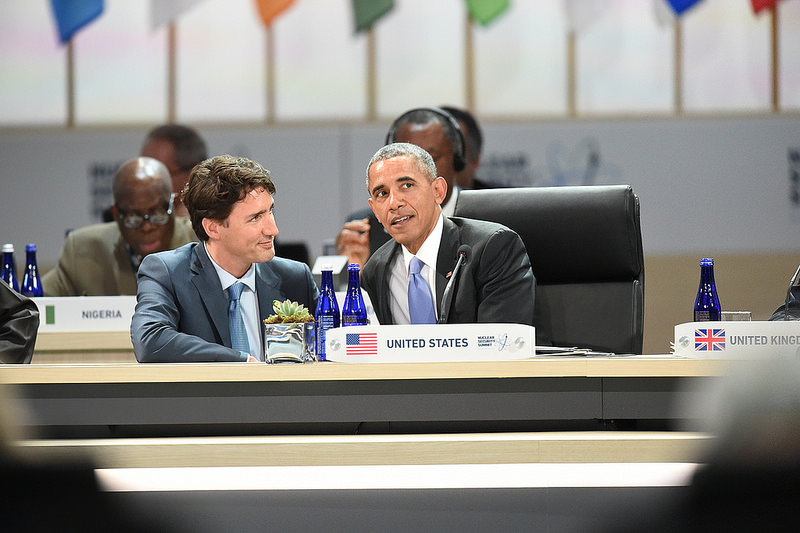The US-Canada released a joint statement outlining Obama and Trudeau’s shared vision on climate policy. Here are some top takeaways:
- The EPA will begin the process of regulating existing sources of methane for the first time, working towards cutting methane emissions by 40 to 45 percent below 2012 levels by 2025;
- The US is the current chair of the Arctic Council, so the announcement of the new science-based safety and economic standard for Arctic commercial activities is likely to have serious ramifications in the climate-vulnerable Arctic region.
It has been 19 years since the White House last hosted a Canadian prime minister. After years of conservative leadership in Ottawa, Prime Minister Justin Trudeau’s first visit to the White House represents a fresh start to Canada-U.S. relations, and an important step in the bilateral action on climate change that was all but impossible under Trudeau’s predecessor, Stephen Harper.
- Unlike Harper, described as “the number one enemy to climate” by Oxfam, Trudeau has become a symbol for progressive environmental policies. As soon as Trudeau took office, he renamed Environment Canada to Environment and Climate Change, created a post for Minister of Science, and lifted Harper’s ban on scientists from speaking to the media.
- During the First Ministers’ Meeting with provincial Premiers last week, Trudeau oversaw the development in four separate areas of clean growth and climate change, including a pan-Canadian carbon price. He also plans to support regional resilience and adaptation projects. These environmental and economic strategies will be implemented by early 2017.
- Trudeau laid out his vision to build a sustainable economy in his New Plan for Canada’s Environment and Economy in 2015. The report calls for investing $200 million in clean technologies and jobs annually; reducing emissions and pollution, especially from the fossil fuel industry and vehicles; protecting Canada’s natural resources; and increasing government transparency and accountability. The creation of a $2 billion Low Carbon Economy Trust will provide funding for projects that materially reduce carbon emissions.
- President Barack Obama and Prime Minister Trudeau are expected to sign a continental strategy that could include provisions on tighter fuel and auto-emission standards, increases in electric vehicles, and methane emissions reductions of up to 45 percent to protect the Arctic. This collaboration will strengthen more than 50 federal and 100 state and provincial arrangements that Canada and U.S. currently share regarding the environment.
Overview of Canada – United States Environmental Agreements Since 1909
For more than a century, Canada and the United States have worked together to prevent and control pollution, as well as protect and restore many ecosystems shared by both countries. Environment and Climate Change Canada and the U.S. EPA meet twice a year to discuss ongoing environmental issues.
2014: California-Quebec-Ontario Carbon Market (Western Climate Initiative)
In 2014, Quebec joined California’s carbon market, followed by Ontario in 2015, all as part of the Western Climate Initiative. The state and provinces will work together to reduce carbon emissions and slow the rate of climate change. Greenhouse gas emission allowances were auctioned in 2015 at a minimum price of $15.84 a ton, and are expected to rise above $20 by 2020.
2010: The Keystone XL Pipeline
Commissioned in 2010, the Keystone is a 1,179-mile oil pipeline that would transport petroleum from Alberta, Canada to refineries in Illinois and Texas. When President Obama rejected the proposal in 2015, it became a symbolic step for strengthening the environmental cooperation between Canada and the U.S.
1991: The U.S. – Canada Air Quality Agreement
The Canada-U.S. Air Quality Agreement addresses transboundary air pollution, which is an issue that arises when airborne pollutants affect air quality many miles away. The Acid Rain Annex of the agreement established emissions reductions of SO2 and NOx, the primary causes of acid rain. The Ozone Annex, added to the agreement in 2000, addresses transboundary O3 by establishing emissions reductions of NOx and VOCs. The progress so far includes: 58 and 78 percent reductions of SO2 in Canada and the United States, respectively, between 1990 and 2012; and cuts to NOx emissions of 45 percent in Canada and 47 percent in the United States between 2000 and 2012.
1988: The Canada-U.S. Arctic Cooperation Treaty
The Canada-U.S. Arctic Treaty encourages cooperation between the two countries regarding the Northwest Passage. It states that, “all navigation by U.S. icebreakers within waters Canada claims as internal will be undertaken with the consent of the Canadian government.” However, the eight nations of the Arctic Council, including U.S. and Canada, are continually entangled in unresolved and contentious boundary disputes.
1972: The Great Lakes Water Quality Management
The Great Lakes Water Quality Management is a commitment to protect and restore the waters of the Great Lakes between Canada and U.S. The agreement was most recently updated in 2012, with provisions that tackle aquatic invasive species, habitat degradation, harmful algae, toxic chemicals, discharge from vessels, and the effects of climate change.
1932: Waterton-Glacier International Peace Park
Canada and U.S. created the world’s first international peace park to show symbol of peace and goodness, as well as to “represent cooperation in a world of shared resources.”
1909: The Boundary Waters Treaty
The Boundary Waters Treaty states that neither country should cause water pollution, which will cause health or property damage in the other country. These waters include: watersheds, migratory fisheries, and their habitats. The treaty also established the International Joint Commission (IJC), which implements the Boundary Waters Treaty and settles issues between the two countries.


